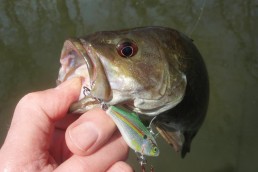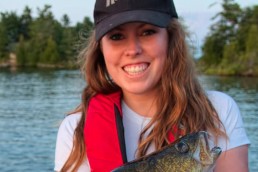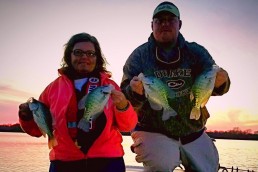Smallmouth Fishing is Great in April
SHARE THIS POST
April—no fooling—is without a doubt a perfect time to be out and about in the Buckeye state. For me, in addition to preparing my gear for the upcoming turkey season, it’s also the best time to get ready for the smallmouths. Nearly 90 percent of my smallie fishing is done in rivers, and there are plans I make for the upcoming season.
My gear choices may seem a bit complex, but they aren’t, and consist only of the tackle that I can carry with me in the pockets of my fishing vest. For lures, I rely first upon lipless crankbaits, both with rattles and those that are silent. Top choices are Rapala Rattlin’ Raps in small to medium sizes in natural colors and the Berkley Frenzy Diving Minnows in similar sizes, but with contrasting colors. Then comes the number 9 Original Rapala Minnow in the Black/Silver, Black/Gold and Blue/Silver, the Rebel Wee Rs in the Baby Bass color, Rebel Wee Craws in the Natural Craw finish, the Yo-Zuri L Minnows in the Rainbow Trout color and the Heddon Tiny Tad in their Black with white herringbone ribs.
When it comes to soft plastics, I like 1 1/2- to 3-inch tubes in a June bug, green pumpkin, black neon and a pumpkinseed color, or a Texas-rigged bait on a Bass Pro Shops Weighted Hook. Hopped or dragged across the bottom, these are all dynamite on smallmouths.
My inline spinner selection runs the gamut from homemade concoctions crafted with parts acquired from Jann’s Netcraft to small- or medium-sized Mepps Aglia spinners in Gold or Silver with contrasting squirrel tails on the treble hooks. Cast these upstream, and retrieved next to any boulders or over shale beds. These offer plenty of vibration and flash to allow marauding predatory fish to hone in on them and attack.
There’s nothing more fun than catching smallmouths on topwater lures. I’ll twitch a small Pop-R across the surface near boulders, laydowns, at the head or at the base of a riffle or in any backwater area. When a fish hits, it will do so with authority.
Are you enjoying this post?
You can be among the first to get the latest info on where to go, what to use and how to use it!
Any fishing pole can be used to catch smallies, but some fit the bill. My preference is either a 6 1/2- or 7-foot spinning rod with a fast retrieve and the reel loaded with 8-pound-test line. For fishing crankbaits, I prefer monofilament line, but since it is rather difficult to switch back and forth in the middle of the stream, I rely on Berkley’s FireLine braid in 8-pound-test line.
Two essential items for river angling are either hip boots or chest-high waders, depending upon depth, and a good wading staff. I don’t go into a river without a staff for support. If there’s one thing I hate it is to fall into a river or come across a sudden depth change. My wading staff has had to use an old broom handle to save me from a dunking more than once.
Smallies, like many river fish, live and die by the current and will spend nearly 100 percent of their day facing into it. From upstream comes their food: minnows, hellgrammites, grasshoppers, worms washed into the river, frogs and tumbling crayfish. An angler’s cast should be made directly upstream, or at least quartering upstream, and retrieved back. My preference is to turn slightly and retrieve the lure a bit past myself. Smallies are notorious followers and often hit a lure just as it is being pulled put of the water. That extra foot or so of a retrieve may be just what is needed for a successful hook-set.
My last piece of advice has to do with the best time to be on or in the water: go whenever you can and as often as you can. At least 90 percent of what I know about smallmouth fishing has been gleaned from spending time on the water. Let the fish teach you how to be successful in your spring smallmouth fishing.
MWO
SHARE THIS POST
Did you enjoy this post?
You can be among the first to get the latest info on where to go, what to use and how to use it!
John Bennett
John Bennett is a retired history teacher, historical re-enactor, father and grandfather. As a four-season outdoorsman, his passion is waterfowl hunting and fishing for smallmouth bass. He lives in Ohio and spends quite a bit of time in his primitive log cabin, which he built.



